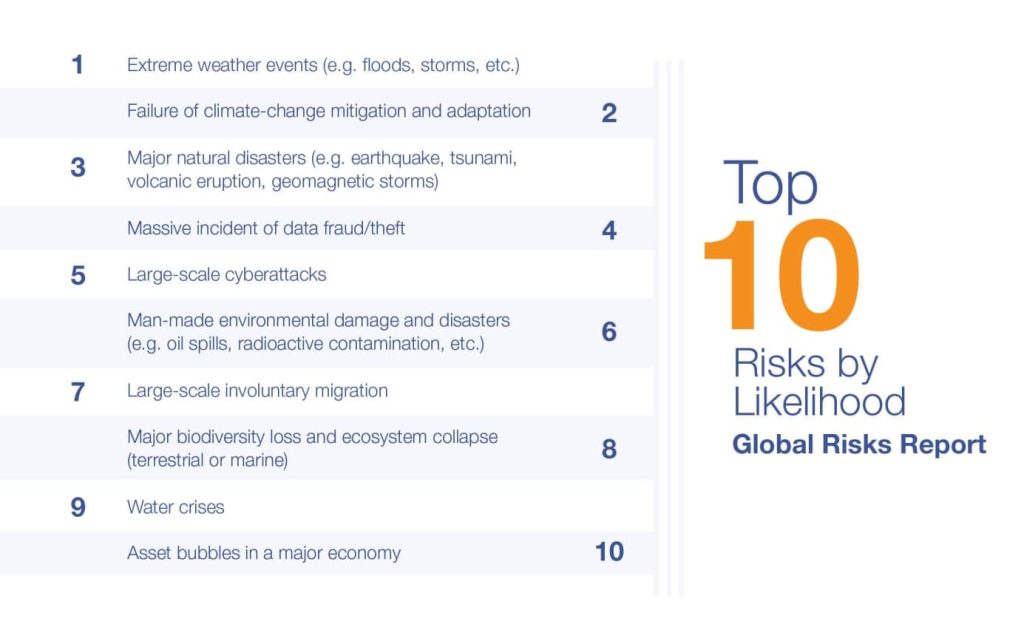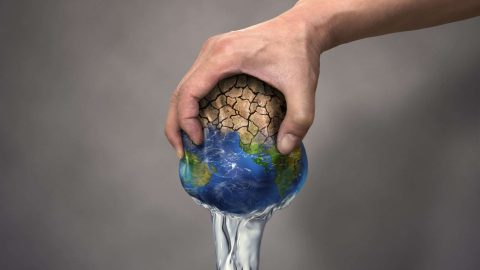Climate risks are omnipresent. Extreme weather events such as floods, storms and cyclones, rising greenhouse emissions, and natural disasters are risks that the World Economic Forum identified as early as in 2011 as among the top five in terms of events occurring with high probability.
In 2019, already three of the top five risks are classified as hailing from the climate category, and if we look at the impact, even four out of five. In addition to natural disasters and extreme weather events, the second rank goes to our inability to adjust to the consequences of climate change and the directly resulting global water crisis. From our point of view, it is therefore essential to prioritise these problems from a sustainable perspective.
How warm will it get?
The Fourth National Climate Assessment by the USA that came out in November 2018 warns that without a reduction in anthropogenic greenhouse emissions, we could be hit by an increase of 5 degrees Celsius in the average global temperature, in comparison to preindustrial times. In order to reach the 1.5 degrees target, we have about twelve years for the relevant course correction according to the IPCC (Intergovernmental Panel on Climate Change). Our ecosystems play an important role as well: oceans and forests act as CO2 storage, and their effectiveness is being compromised by global warming. Coastal mangrove forests are an example of our dependence on the functioning of these systems: some 200mn people live and cultivate food in these areas, and they depend on mangroves for protection against storm floods and rising sea levels. The World Wide Fund for Nature has warned that mangroves have been gradually eliminated since the middle of the 20th century, which has resulted in a massive degree of CO2 release, because the CO2 storage capacity of these forests is about three to five times higher than that of terrestrial forests.

Source: WEF (World Economic Forum)
Along with marine and terrestrial systems, anthropogenic systems are also directly affected. According to IPCC data, the majority of studies scrutinised shows a negative relationship between crops and climate warming, especially in grain and corn (less so in rice and soy).
What role does the sea play?
Quickly growing cities and the persistent effects of climate change make more people susceptible to the rise in sea levels. By 2050, two thirds of the world’s population are expected to live in cities. The WEF (World Economic Forum) estimates that 800mn people already live in more than 570 coastal cities that are subject to a rise in sea level of 0.5 metres by 2050.
In a vicious circle, urbanisation is not only focused on people and their property in potential regions of damage and disruption, but it also causes these risks to increase – for example by destroying natural sources of resilience such as coastal mangroves and contaminating ground water. The intensified effects make more and more land uninhabitable. According to the report, there are three main strategies to adjust to rising sea levels: 1) engineering projects to contain the water, 2) natural/environmentally-based solutions, and 3) people-focused strategies, e.g. moving households and companies to safer areas, or investing in social capital so as to make communities that are subject to flood risk more resilient.
“The increase of the coastal sea level is one of the gravest social consequences of climate change. The global increase of the average sea level will continue over centuries due to global warming. The detailed progress and the definitive rise depend significantly on the future greenhouse emissions,” as Pavel Kabat, Director of Research at the WMO (World Meteorological Organization) explains.
Good bye, biodiversity?
Climate change adds to the loss in biodiversity. Many affected ecosystems such as oceans and forests are crucial to absorbing carbon dioxide emissions. Increasingly fragile ecosystems also harbour risks for social and economic stability. Given that environmental risks tend to form clusters as they manifest themselves in more frequent and severe ways, the effects on the global value chain will probably increase and weaken resilience overall.
Conclusions of the Global Risk Report
Environmental risks continue to dominate the results of the annual Global Risks Perception Survey (GRPS). The consequences of climate change are becoming clearer by the day. The accelerating loss in biodiversity is particularly worrisome. Since 1970, it has declined by 60%. In the human food chain, the loss in biodiversity affects health and the socio-economic development, which in turn has an impact on well-being, productivity, and even regional safety.
The disruption of production and supply of goods and services due to environmental disasters has increased by 29% since 2012. North America was the region that was hardest hit by environmentally triggered supply chain disruptions in 2017. These disruptions were largely due to hurricanes and forest fires. In the US automotive industry for example, only factory fires and company mergers caused more disruptions to the supply chain than hurricanes that year. Measuring the disruptions by number of suppliers affected rather than number of individual events, the four most important causes of disruptions in 2017 were hurricanes, extreme weather, earthquakes, and floods.
Shifts in the global waste management and recycling supply chain in 2018 could be a foretaste of what is to come. China banned the import of waste from abroad (among it almost 9mn tonnes of scrap plastic) in order to reduce environmental impact. The ban revealed weaknesses in the domestic recycling capacity of many Western countries. In the first half of 2018 alone, the United States sent 30% of the plastic that would have been dumped in China to other countries such as Thailand, Malaysia and Vietnam.
Disclaimer:
Forecasts are not a reliable indicator for future developments.
Legal disclaimer
This document is an advertisement. Unless indicated otherwise, source: Erste Asset Management GmbH. The language of communication of the sales offices is German and the languages of communication of the Management Company also include English.
The prospectus for UCITS funds (including any amendments) is prepared and published in accordance with the provisions of the InvFG 2011 as amended. Information for Investors pursuant to § 21 AIFMG is prepared for the alternative investment funds (AIF) administered by Erste Asset Management GmbH pursuant to the provisions of the AIFMG in conjunction with the InvFG 2011.
The currently valid versions of the prospectus, the Information for Investors pursuant to § 21 AIFMG, and the key information document can be found on the website www.erste-am.com under “Mandatory publications” and can be obtained free of charge by interested investors at the offices of the Management Company and at the offices of the depositary bank. The exact date of the most recent publication of the prospectus, the languages in which the fund prospectus or the Information for Investors pursuant to Art 21 AIFMG and the key information document are available, and any other locations where the documents can be obtained are indicated on the website www.erste-am.com. A summary of the investor rights is available in German and English on the website www.erste-am.com/investor-rights and can also be obtained from the Management Company.
The Management Company can decide to suspend the provisions it has taken for the sale of unit certificates in other countries in accordance with the regulatory requirements.
Note: You are about to purchase a product that may be difficult to understand. We recommend that you read the indicated fund documents before making an investment decision. In addition to the locations listed above, you can obtain these documents free of charge at the offices of the referring Sparkassen bank and the offices of Erste Bank der oesterreichischen Sparkassen AG. You can also access these documents electronically at www.erste-am.com.
Our analyses and conclusions are general in nature and do not take into account the individual characteristics of our investors in terms of earnings, taxation, experience and knowledge, investment objective, financial position, capacity for loss, and risk tolerance. Past performance is not a reliable indicator of the future performance of a fund.
Please note: Investments in securities entail risks in addition to the opportunities presented here. The value of units and their earnings can rise and fall. Changes in exchange rates can also have a positive or negative effect on the value of an investment. For this reason, you may receive less than your originally invested amount when you redeem your units. Persons who are interested in purchasing units in investment funds are advised to read the current fund prospectus(es) and the Information for Investors pursuant to § 21 AIFMG, especially the risk notices they contain, before making an investment decision. If the fund currency is different than the investor’s home currency, changes in the relevant exchange rate can positively or negatively influence the value of the investment and the amount of the costs associated with the fund in the home currency.
We are not permitted to directly or indirectly offer, sell, transfer, or deliver this financial product to natural or legal persons whose place of residence or domicile is located in a country where this is legally prohibited. In this case, we may not provide any product information, either.
Please consult the corresponding information in the fund prospectus and the Information for Investors pursuant to § 21 AIFMG for restrictions on the sale of the fund to American or Russian citizens.
It is expressly noted that this communication does not provide any investment recommendations, but only expresses our current market assessment. Thus, this communication is not a substitute for investment advice.
This document does not represent a sales activity of the Management Company and therefore may not be construed as an offer for the purchase or sale of financial or investment instruments.
Erste Asset Management GmbH is affiliated with the Erste Bank and austrian Sparkassen banks.
Please also read the “Information about us and our securities services” published by your bank.


